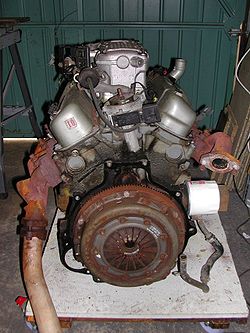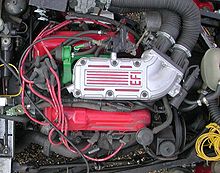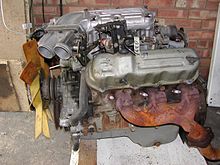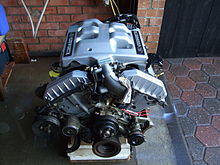- Ford Cologne V6 engine
-
Ford Cologne V6 
Manufacturer Ford Motor Company Also called Ford Taunus V6 Cylinder block alloy cast iron Valvetrain pushrod overhead-valve The original Ford Cologne V6, also known as the 'Ford Taunus V6', is a series of 60° cast iron block V6 engines produced continuously by the Ford Motor Company in Cologne, Germany since 1968. In its original form, it was closely related to the Ford Taunus V4 engine, adding two cylinders and no longer requiring a balance shaft.
Throughout its production run, the Cologne V6 has evolved from the engine displacements of 1.8, 2.0, 2.3, 2.4, 2.6, 2.8, 2.9 and 4.0 litres engines. All except the Cosworth 24v derivative and later 4.0 litre SOHC engines were pushrod overhead-valve engines, with a single camshaft between the banks. The 4.0 litre SOHC version remains in production and is the only version of the engine currently offered, with 210 hp (160 kW) and 240 ft·lbf (330 N·m) torque.
Originally, the Cologne V6 was installed in vehicles intended for Germany and continental Europe, while the British "Essex" V6 was used in cars for the British market. Later, the Cologne V6 largely replaced the Essex V6 for British-market vehicles. These engines were also used in the United States, especially in compact trucks.
The older fuel injected Cologne engine is lighter and more powerful than the equivalent Essex V6 even though its maximum engine displacement is smaller, but it produces less torque (Cologne V6 162 lb·ft (220 N·m) versus Essex V6 174 ft·lbf).
The Cologne V6 was made to be very compatible in installation with the Taunus V4, having the same transmission bolt pattern, the same engine mounts, and in many versions, a cylinder head featuring "siamesed" exhaust passages, which reduced the three exhaust outlets down to two on each side. The latter feature was great for compatibility, but poor for performance. The 2.4, 2.9 and 4.0 had three exhaust ports, making them preferable.
The engine was available in both carburetted and fuel injected form.
Contents
1.8
The smallest version of the V6 was the 1,812 cc (1.812 L; 110.6 cu in) with a 80.0 mm (3.15 in) bore and a 60.14 mm (2.368 in) stroke. Its output was 82 hp (60 kW) and 135 N·m (100 lb·ft). Its only application was the
- Ford 17M P7 from 1968 to 1971.
2.0
The original displacement of the V6 was 1,998 cc (1.998 L; 121.9 cu in) with a 84.0 mm (3.31 in) bore and a 60.14 mm (2.368 in) stroke. Output was 85 hp (63 kW) and 151 N·m (111 lb·ft) or 90 hp (66 kW) and 158 N·m (117 lb·ft).
Applications:
- 1964-1967 Ford Taunus 20M P5
- 1967-1968 Ford 20M P7.1
- 1968-1971 Ford 20M P7.2
- 1969-1981 Ford Capri I - III
- 1970-1976 Ford Taunus TC
- 1976-1979 Ford Taunus II
- 1979-1982 Ford Taunus III
- 1975-1977 Ford Granada I
- 1977-1985 Ford Granada II
- 1982 Ford Sierra (Not available in UK models)
2.3
The first enlargement of the V6 appeared in 1967. It was the 2,293 cc (2.293 L; 139.9 cu in) with a 90.0 mm (3.54 in) bore and a 60.14 mm (2.368 in) stroke. Output was 108 hp (79 kW) and 185 N·m (136 lb·ft) or 125 hp (92 kW) and 187 N·m (138 lb·ft).
- 1967-1968 Ford 20M P7.1
- 1968-1971 Ford 20M P7.2
- 1969-1974 Ford Capri I
- 1974-1978 Ford Capri II
- 1978-1985 Ford Capri III
- 1971-1976 Ford Taunus TC
- 1976-1979 Ford Taunus II
- 1979-1982 Ford Taunus III
- 1977-1979 Ford Cortina IV
- 1979-1982 Ford Cortina V
- 1972-1977 Ford Granada I
- 1977-1985 Ford Granada II
- 1982-1984 Ford Sierra I
2.6
The largest first generation V6 was the 2,550 cc (2.55 L; 156 cu in) introduced in 1969. It had a 90.0 mm (3.54 in) bore and a 66.8 mm (2.63 in) stroke. Output was 125 hp (92 kW) and 205 N·m (151 lb·ft).
Applications:
- 1969-1971 Ford 26M
- 1970-1974 Ford Capri
- 1972-1977 Ford Granada
2.6 RS
There was a special high performance version with 2,637 cc (160.9 cu in) with a 90.0 mm (3.54 in) bore and a 69.0 mm (2.72 in) stroke. With fuel injection, it produced 150 hp (110 kW) and 219,5 Nm. It was the only first generation engine with fuel injection. Its only application was the
- Ford Capri 2600 RS from 1970 to 1974.
2.8
The second generation Cologne V6 was introduced in 1974. It displaced 2.8 L (93.03 mm Bore, 68.5 mm Stroke, 2,792 cc or 170.4 cu in) and used a geared camshaft design. The European version used a "siamesed" two-port exhaust manifold, similar to the one used on the V4, while the American version used three-port heads. The European approach was useful in that existing cars with the V4 engine could be upgraded with relative ease. Output was rated at 90 to 115 bhp (86 kW) for the US market and anywhere from 130 to 160 bhp (119 kW) for the European market, depending on the model.
In Europe the 2.8 was produced with carburetor (132 bhp), mechanical fuel injection (Bosch K-Jetronic, 160 bhp), and electronic injection (Ford EEC-IV, 150 bhp). Electronic injection only featured on the 2.8 Granada models for one year before being replaced with the 2.9 unit.[citation needed]
Tuning options are very limited with the Bosch K-Jetronic models. The siamesed inlet and exhaust ports of the 2.8 only respond well to forced induction or an overbore; normal tuning will yield only minor power results. The MFI 2.8 Cologne ( Capri / Sierra 2.8i ) uses a very restricted induction setup, and there is no open air kit available due to this.[citation needed]
TVR Tasmin/280i used the Cologne 2.8 with Bosch K-Jetronic fuel injection, as did the early TVR 'S' series in 2.8 and revised 2.9 efi injection form.
Applications:
- TVR 280i/Tasmin
- TVR S Series
- Ford Ranger
- Ford Bronco II
- Ford Aerostar
- Ford Pinto
- Mercury Bobcat
- Mercury Capri
- Ford Mustang II
- Ford Granada
- Ford Capri III
- Ford Sierra
- Ford Scorpio
- Bandvagn 206
- Reliant Scimitar (1979 onwards)
- Panther Kallista
2.9
The 2.9 L shares the same basic design as the 2.8 L model, bar a few subtle differences. The camshaft is chain-driven rather than gear driven, so it rotates in the same direction as the crankshaft. The arrangement of the exhaust valves is different, eliminating the "Hot-Spot" that existed on the 2.8 L model. The cylinder heads also sport a more conventional three-port exhaust manifold. Output was rated at 140 hp (104 kW) @4600 rpm for the Light trucks (1986-92 Ranger & 1986-90 Bronco II) and 144 hp (107 kW) @4800 rpm for the Merkur Scorpio in the US market and anywhere from 150 to 160 hp (112 to 119 kW) for the European Market.
Bore was 93 mm (3.661 in) and stroke was 72 mm (2.835 in) for a total displacement of 2.9 L (2935 cc/177 cu in).
In Europe, this engine was commonly fitted with the Bosch L-Jetronic fuel injection system, married to Ford's EEC-IV engine management. Because of this difference over the 2.8 L model, this version was a more popular candidate for after market modification (typically turbocharging) from companies such as Janspeed and Turbo Technics.
Applications:
- TVR S2/S3(C)/S4C
- Ford Bronco II
- Ford Ranger
- Ford Sierra XR 4X4
- Ford Granada
- Ford Transit
- Merkur Scorpio
- Panther Kallista
North American 2.9 reliability
The North American version of this engine suffered from several serious reliability issues over its lifespan.
Cylinder head cracking was very common in early models, but affected all model years. Compared to the relatively stout European heads, the North American 2.9 had apparently been subject to a reduction of material around the valve stem guides and rocker shaft mounting pedestals. Some engines would suffer from this failure after overheating only once, while some would fail without overheating at all.
The cylinder heads underwent a redesign for the 1989 model year, receiving additional material in some problem areas. This helped to reduce the chances of this specific failure, but it was still an issue. Some of these head castings are supposedly printed with the "89TM" designation, but there has been no verification of these claims as the "86TM" designation is usually found on the 1989 and newer heads as well. The redesigned heads also have larger diameter bosses for accessory mounting than the 1st design heads.
After-market heads are also available from World Products, with better design improvements to the early OEM design. These heads use the early model narrow bosses for accessory mounting, so fitment of 1989 and newer accessory brackets will require modification.
Additionally, oiling problems were common, and added to the poor reputation of the North American 2.9. Although these problems mainly affected poorly maintained or high mileage engines, it occasionally affected low-mileage engines with proper maintenance as well. The symptom of these problems is serious valve train noise. This is due to a number of design faults. Valve train oil pressure was entirely dependent upon a supply fed through the two center cam bearings. Even slight bearing wear could cause complete loss of oil pressure to the hydraulic valve lifters, rocker shaft, and rockers. Excessive internal "bleeding" through the half-moon camshaft thrust plate also contributed to this, though this can possibly be remedied by reinstalling the thrust plate in an upside-down position.
In the event that a cylinder head crack occurs, coolant can often enter the crankcase, contaminating the oil. This quickly leads to cam bearing damage, triggering valve train oil pressure loss. As a result, these two design faults have led to catastrophic engine failure in many North American 2.9s.
Regardless of these problems, many of these engines are still on the road in the US, and when maintained properly, can be highly reliable powerplants. Regular oil changes and stringent cooling system maintenance is essential if owners of early-model 2.9s wish to avoid trouble.
2.9 Cosworth
A special twin DOHC (QUAD CAM) version of the 2.9 was created by Cosworth Engineering in 1991 ( Code BOA ). Although it shared the same block as the standard 2.9 (with a few machining operations left out to improve strength), power output was up to 195 PS (143 kW) and torque was boosted to 203 ft·lbf (275 N·m) at 4500 rpm. This engine was used in the Ford Scorpio Cosworth 24V. It was always mated to an improved A4LD ( A4LDe (small e)) automatic gearbox. No manual versions were available, although there has been a number of aftermarket manual conversions done to them.
The engine used an almost 3-metre (9.8 ft) long duplex chain to drive the camshafts, tensioned by a hydraulic tensioner. The oil pump was driven by a shaft located where the camshaft previously was. The ignition was replaced by a distributorless EDIS-6 system which had no moving parts at all.
The engine was known for its substantial increase in power delivery above 4000 rpm relative to the unmodified version; in recent years the engine has become a popular choice as a replacement engine for Ford Sierras.
An improved version of this engine (code BOB) was available in the restyled 1995 Ford Scorpio. Differences included two simplex chains with two hydraulic tensioners and the addition of a variable length intake system called VIS. Power output was increased to 210 bhp (157 kW). This was mated to a fully electronically controlled A4LDE (big E) Autobox.
4.0
The 4.0 L pushrod (245 CID; 4009 cc) version, although produced in Cologne, Germany, was only fitted to American vehicles.[1] The OHV engine was produced until 2000 and was used in the Ford Explorer, Ford Aerostar, Mazda B4000 and Ford Ranger. Output was 160 hp (119 kW) and 225 ft·lbf (305 N·m). Though there is some variation, typically 155 hp (116 kW) is quoted as horsepower for 1990-92 applications.[citation needed]
This evolutionary redesign of the American 2.9 solved many of the reliability issues that plagued its predecessor. A stronger cylinder head design eliminated the 2.9's common failure of cracked heads. Hydraulic roller lifters replaced the simple hydraulic lifters used in the 2.9, which were sometimes overly sensitive to oil contamination, often requiring the lifters to be replaced prematurely. However, one major design fault was not completely eliminated: Valve rockers and upper pushrod tips still received poor oil supply, resulting in eventual wear to these areas, and consequential valvetrain noise as a result of the increased clearance. Required replacement of these parts is common in older engines.[citation needed]
Applications:
- Ford Ranger/Mazda B-Series
- Ford Explorer/Mazda Navajo
- Cross Lander 244X
- Ford Aerostar (1990–1997)
SOHC
Currently the only version of the Cologne engine still in production, the SOHC version was introduced in 1997 in the Ford Explorer, alongside the original pushrod version. It features a variable length intake manifold and produces 210 hp (157 kW) and 254 lb·ft (344 N·m)f. It uses a jackshaft in place of a camshaft to drive a timing chain to each cylinder head. Three timing chains are used, one from the crank to the jackshaft, one in the front of the engine to drive the cam for the left bank, and one on the back of the engine to drive the cam for the right bank. Ford Power Products sells this engine as the SOHC-640.[2]
A version of the engine is used in the Land Rover LR3 in Australia and Canada, producing 216 hp (161 kW) and 250 lb·ft (339 N·m) of torque at 3,000 rpm. The Land Rover version of the engine became unavailable in the United States for the 2008 model year.[3]
Applications:
- 2001–present Ford Ranger
- 2001–2010 Mazda B4000
- 1997–2010 Ford Explorer/Mercury Mountaineer
- 2005–2010 Ford Mustang
- 2005–2009 Land Rover LR3
Turbo and supercharging
A number of companies has produced forced induction versions of the engine. Sprintex produced supercharged 2.8/2.9. Janspeed produced single and twin turbo 2.8/2.9 engines.
Turbo Technics produced single and twin 2.8/2.9 2.8 single 200 bhp (150 kW) 2.8 single 220 bhp (160 kW) 2.9 twin 225 bhp (168 kW) 2.9 twin 250 bhp (190 kW) 2.9 twin 280 bhp (210 kW) 2.9 twin 323 BHP 2.9 Minker
Explorer Express has also developed a series of Eaton Roots type supercharger systems producing from 6-11 psi of boost for the 4.0 engine.
A limited number of 24V BOA/BOB's have been forced also.and a racing version of boa called BOE(naturally aspirated)
2.3 turbo may was available in 20m/capri/granada/osi it had 188 hp 2.6 Turbo may in was available in same cars with 207 hp 2.8 Turbo may came later and with 200 hpeichberg 2.8i turbo was also available
Capacity increases
In 1991 increased capacities for the 2.8 and 2.9 engines (3.5 and 3.7 litres, respectively), were first developed and introduced by D.P. Davies and sold by his company, VeeTech Engineering, in the UK. Two companies still produce large capacity conversions on the 2.8 & 2.9: Power Engineering and Specialised Engines..
Other cars using the Cologne V6
- Ford Capri
- Mercury Capri
- Ford Consul
- Ford Granada
- Ford Cortina
- Ford Sierra
- Ford Scorpio
- Merkur Scorpio
- Ford Transit
- Ford Aerostar
- Panther Kallista 2.8L
- Panther Kallista 2.9i
- Reliant Scimitar SE6b
- TVR Tasmin series (a.k.a "Wedge")
- TVR S series (S1, S2, S3, S4)
References
- ^ [1][dead link]
- ^ Ford, Ford Power Products Catalogue.
- ^ "Land Rover LR3 Review ''Edmunds''". Edmunds.com. 2010-08-11. http://www.edmunds.com/landrover/lr3/review.html. Retrieved 2011-01-06.
- Anderson, Doug. Rebuilding The Ford 4.0L Pushrod V6, Engine Builder, April 2001.
Categories:- Ford engines
- Goods manufactured in Germany
Wikimedia Foundation. 2010.





